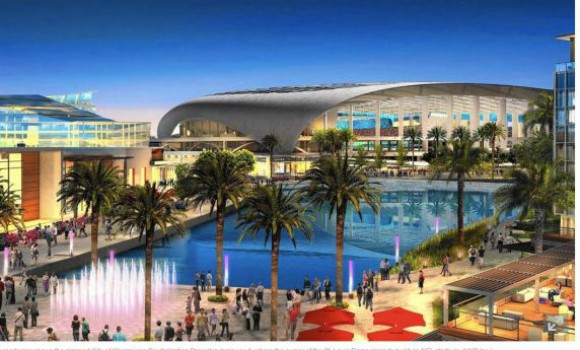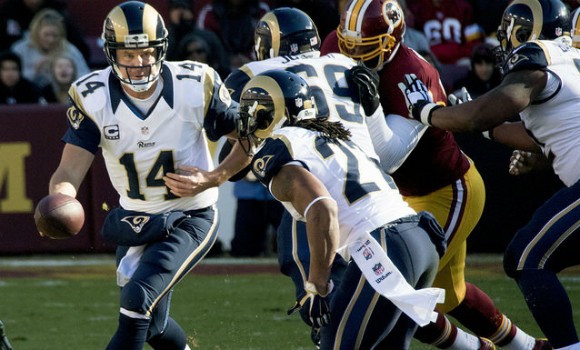For decades, new sports stadiums have presented taxpayers with a big dilemma. Either they had to shell out hundreds of millions of dollars to bring a new team to their city, or spend equal amounts to keep one from leaving.
The NFL, NHL, NBA and MLB combined have pulled in close to $20 billion in public funding since 1990, according to NPR.
Now, attitudes toward taxpayer subsides for stadiums are changing. Communities that once funded sports development projects without a second thought are sometimes reluctant to forfeit a dime.
When the plan for the latest high profile stadium — a dome for the Rams in a Los Angeles suburb — was unveiled last Monday, something was missing: public funding.
The Rams, who decamped from Southern California for St. Louis after 1994, are gunning for a LA return in the suburb of Inglewood. There, in partnership with the Kroenke Group ( owner Stan Kroenke’s company) and other developers, they hope to build a new dome for the team along with community homes and entertainment venues.
Here’s a mockup of the proposed project:

However, the plan has a significant catch. Though there will be no upfront taxpayer subsidies for the proposed project, Inglewood could end up owing developers $100 million in reimbursements, according to AP.
“While the plan does not include any upfront tax money to build the 298-acre community of homes, offices and entertainment venues, a 187-page outline released by developers includes provisions for multimillion-dollar public paybacks to them over time from tax dollars generated by the project, which would cover costs ranging from installing street lights and fire hydrants to running shuttle buses and providing police security on game days.”
Despite these hidden costs, Inglewood mayor James Butts believes the town will benefit from the development in the long run, and residents will vote on the proposal later this year.
Before they do so, there’s a few things Inglewood voters should keep in mind.
First, stadium costs rarely stay on budget.
When new homes for the Yankees and Mets were approved in the mid-2000s, the price tags were estimated to be $1 billion and $645 million. The city and state promised to fund significant portions of these projects, 20 percent for the Yankees and 35 percent for the Mets.
As the New York Times points out, these funding percentages were considered to be conservative at the time when compared to other developments. In comparison, San Diego taxpayers picked up a whopping 67 percent of the Padres’ new stadium that opened in 2004.
When all was said and done, however, both projects went far over budget with Yankee Stadium costing approximately $1.5 billion and Citi Field $900 million. Public subsidies rose as their price tags skyrocketed, and hundreds of millions of tax-exempt bonds were issued to the teams to help them complete their new homes. The Independent Budget Office put the final taxpayer cost at $1.2 billion.
To add insult to injury, a huge chunk of this money ($237 million in tax-exempt bonds) went to building a Yankee Stadium parking lot that had a 38 percent occupancy rate as of 2012. It owes the city $48 million in unpaid taxes, and charges fans $70 to park there for three hours.
Beyond construction costs, the return on building a new stadium is not as beneficial as it might seem.
It turns out that consumer spending on these venues might just be shifting money from one part of an economy to another.
“The basic idea is that sports stadiums typically aren’t a good tool for economic development,” Holy Cross Economist Victor Matheson told the Atlantic. “Take whatever number the sports promoter says, take it and move the decimal one place to the left. Divide it by ten, and that’s a pretty good estimate of the actual economic impact.”
While Kroenke’s deal for Inglewood might not be all that it seems, it still appears to be much sweeter than St. Louis’ alternative.
The city wants to build a $900 million open air stadium that would cost local and state taxpayers half that price. Some St. Louis leaders casted serious doubt on the public’s willingness to go along with that project when they spoke to the Los Angeles Times.
“They gave the Rams the sun, the moon and the stars back then. And the Edward Jones Dome isn’t even paid off yet,” the Coalition Against Public Funding for Stadiums told the LA Times. “Now they want to start all over again? It doesn’t make any sense.”
Before the Rams can move to Southern California they need approval from fellow NFL owners, and they might meet strong resistance from the San Diego Chargers who are considering litigation to prevent the Rams from moving to Los Angeles.
And right now no NFL teams are permitted to move before 2016, so there’s still plenty of time for new factors to arise.
But just like the economics of hosting the Olympics and other major sporting events, building a new sports stadium is murky business for taxpayers.
STORY IDEAS
- How the Olympics helped ruin Greece’s economy
- The NFL usually gets what it wants
- Chargers hint at litigation










